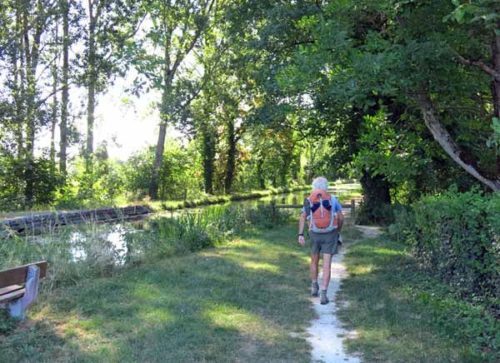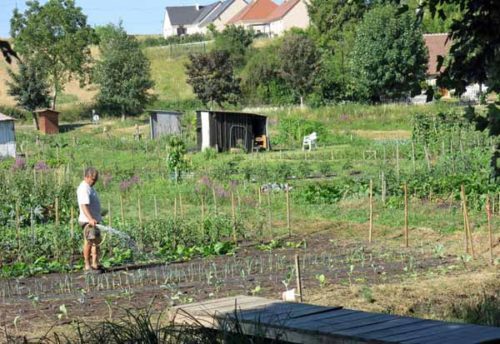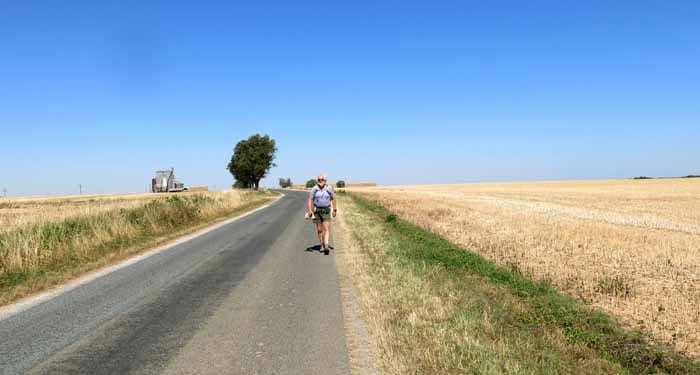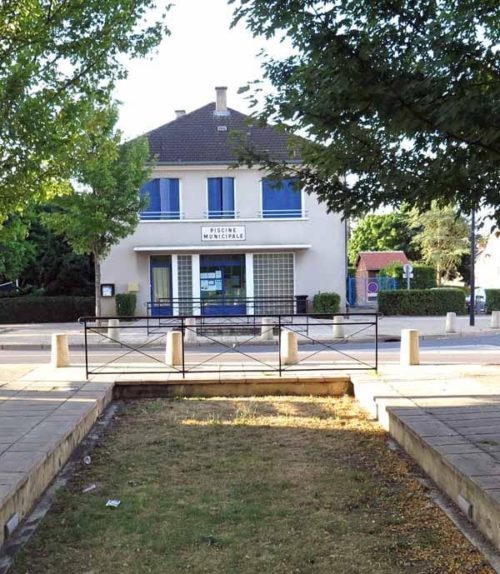Friday, 10 July 2015
Distance 32 km
Duration 6 hours 30 minutes
Ascent 100 m, descent 70 m
Map 134 of the
During the night we were annoyed by some mosquitoes that had found their way inside our netted inner tent. Also it was uncomfortably hot, and on top of that, the accursed mattress was still leaking, although not as badly as before, and with my lesser weight it almost lasted until dawn.

Conscious of the long day’s walking ahead, we left early and were back on the canal by 6:45 am. Not on the watery part of the canal, but in the sheltering arcade of the great trees.
This soon gave way to a large lake at the edge of the town, formed by the damming of the river Auron. There was a nautical centre with many small boats tied up and the path wandered through parkland beside the water, under a marching line of electricity pylons.
As we walked we had the company of early morning joggers, dog-walkers, pram-pushers and the like, and it seemed the moment to bring out our marching breakfast of cold quiche. It was heavy, tasteless and horrible, and the grease stuck to the roof of our mouths, so we decided that starvation was the better option.

We had hopes of a bar at Plaimpied, about ten kilometres away. All four pieces of quiche ended up in the canal later on.
At the far end of the lake we looked back to Bourges. Beyond the rows of new apartments on the near shore, the town was no more than a smudge, except for the mighty bulk of the cathedral. It must have been a truly awe-inspiring sight for approaching travellers in the thirteenth century.

We were looking for the exit point of the canal but we missed it and found ourselves going back towards Bourges up the other side of the lake. This was an annoying mistake and as soon as we could we got off the track onto a road, then doubled back to pick up the canal.
Another annoyance for me was that the tingling pain in my elbow had returned, ominously like the shingles I had suffered last year, with its mysterious recurrence two weeks ago.
Then I noticed an insect bite on my elbow and realised that both this and the previous pain were a reaction by my damaged nerves to a sting, not a full relapse, so I cheered up wonderfully.
Resuming our progress on the canal, or rather in the grassy tunnel that marked its former bed, we walked for a couple of kilometres under the leaning trees and came to the remains of a lock.
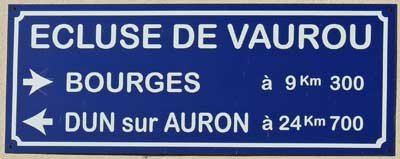
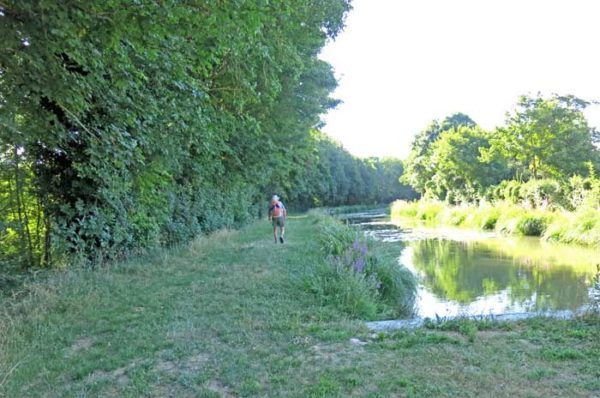
Here the canal proper began again. At first it was shallow and weedy, but after the lock of Vaurou it looked positively navigable.
We crossed to the other bank and soon saw the sturdy church of Plaimpied-Givaudins ahead.
The village was on a bend of the canal (and the river) and the street rose steeply from the bridge.
We found a bar opposite the church and went in to make up for lost time in the matter of refreshments.
As I was feeling the effects of lack of sleep, Keith gallantly went off to get pastries.
He was away a long time, as the boulangerie was nowhere near the bar, but eventually he came back with three lovely fat croissants and we had two rounds of coffee to help them down.

Magically strengthened by this break, we descended to the canal and continued along the towpath for another hour.
It was a peaceful scene – people tending their vegetable gardens, ducks fossicking on the banks, the occasional otter splashing into the water – but we were conscious of how different things had been after the German invasion, which was still within living memory.
The line of demarcation between the zone occupied by the Germans and the so-called “free” zone under the control of the collaborating French led by Petain, passed across the canal at this point. People risked their lives to help escaped prisoners, Allied pilots, partisans and Jews to slip past the guard posts.
Not much further on, we were forced off the towpath when it became too overgrown. We were not sorry about this, as there were a couple of long snaking loops of the canal ahead that looked unnecessarily circuitous.
A steep pull up brought us to the D106 and we set off along it. On either side stretched a sunbaked tableland of wheat, corn and sunflowers and the road was as straight as an arrow – the Romans would have been proud of it.
My Roman emperor for today was Diocletian, with his amazing taxation system that allowed all citizens to pay in whatever currency they had, whether it was wheat, boots, pots, mule transport or just manual labour.
We crossed another road, as devoid of traffic as the one we were on, and pressed on for another hour, passing a few small settlements, roadside crosses and patches of trees. At the entry to the hamlet of Villaine we veered to the right around a belt of thick forest that exuded coolness, although the sun was too high in the sky to give us actual shade.
Just past a double line of high-tension wires, the road dipped and we took a crunchy gravel lane that plunged off to the left, crossed a wooded stream and climbed in zig zags to another plain. Once again meeting the high-tension wires, we joined a tar road and turned south.
Another hour passed as we trudged along through acres of wheat stubble, the resultant bales stacked up beside the road like blocks of flats. In one field the stubble had been burned.
Our shadows had shrunk to black spots under our feet and we were getting tired, as we had been walking for more than six hours. Normally we arrive at our destination before lunch.
At last our little road merged into a bigger one and we started to pass the first houses and factories of Dun-sur-Auron.
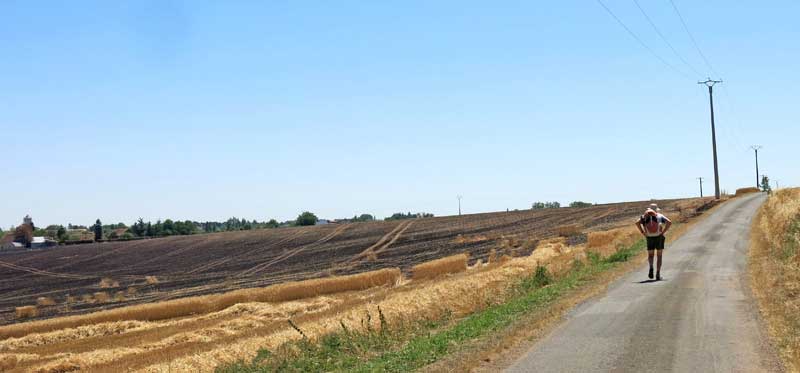
Then we noticed that the canal had reappeared beside us, with the tents and caravans of the camping ground visible across the water.
We looked for a way to cross over, but in the end we had to keep going to the main intersection of the town and double back considerably.
The camping ground was a strip of dead and dying grass between a road and the canal, covered with leaves from a line of mature trees on the water’s edge.
We began to put up the tent, whereupon a fat lady in a deck chair nearby heaved herself up and came over to warn us about the tree roots on the ground, which was nice of her and probably the most exercise she had had all day.
It was too late for lunch, and anyway we were much more interested in showers and a sleep.
We hung our wet washing on the fence and stretched out in the shade for a nap, but were interrupted very politely by the manager, who invited us to go to the office and pay our €5.80.
At about 4:30 pm we went for a stroll in our clean clothes and sandals, to look for somewhere to eat tonight.
At the intersection where we had first arrived, the only shops were a pizza take-away and a closed bar. The town’s swimming pool straddled the canal, which had been filled in at that point.
Things improved as we walked up the rising main street with its plane trees and spruce little whitewashed houses. We passed a boulangerie, a fruit shop and various others before we got to a promising looking tree-lined avenue going off to the right.
There were more shops here, and at the Office of Tourism we got the good news that there were two restaurants face to face further along the street.
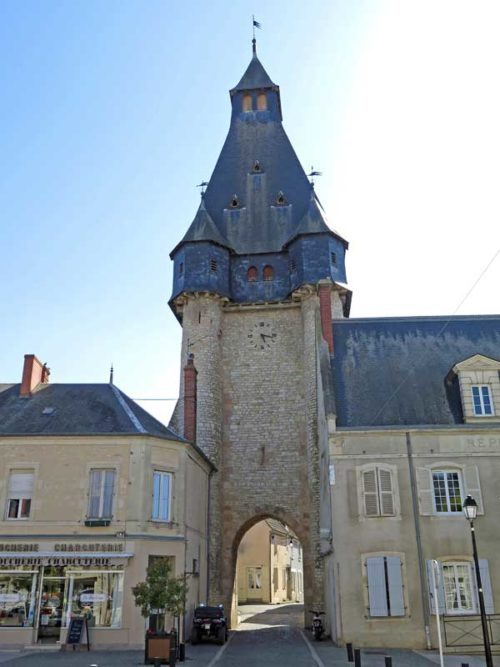
We also found out that the original name of the village had been Dun-le-Roi, ever since it was sold to the French crown in 1101, but after the Revolution the citizens, anxious to keep out of trouble, tactfully changed it to Dun-sur-Auron.
Then when the monarchy was restored they reverted to the older name, only to hastily change back in 1880, when the Third Republic was established.
A gleaming black, oddly shaped bell tower in a row of more recent buildings was, we learned, a remnant of the defensive wall built by the thirteenth-century king Phillipe Auguste.

Nearby was a bar, with people sitting in the shade on the wide pavement. It was a lively scene but quite different from yesterday in Bourges, where everybody was a tourist. Here they were all locals, except for us of course.
In deference to the heat, we had little round-bellied bottles of Orangina instead of coffee.
Before dinner we went through the portal of the bell tower, and wandered about in the old town. It was a maze of lanes lined with tumbledown houses in the process of gentrification.
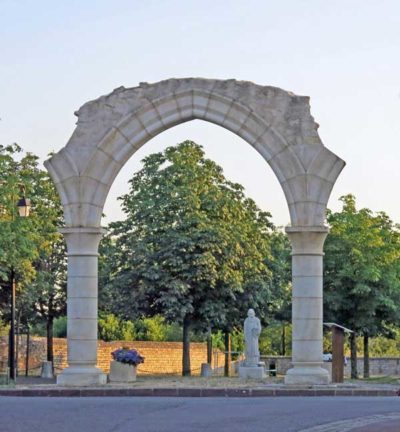
At the far end was a little park with a picturesque ruined arch and beyond that a section of the original ramparts hanging high above the river.
Returning to the street of the restaurants, we looked at the menus and decided on the Hotel de la Poste rather than the Hotel du Jardin des Remparts. This was mainly because the cheapest menu at the latter was €38, which seemed a bit too flash for us.
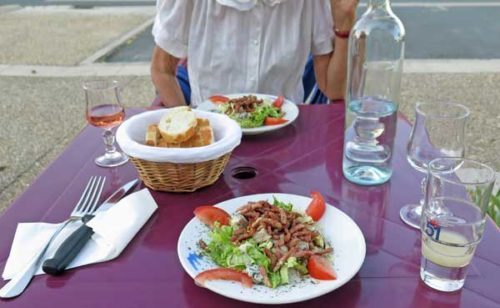
We took a table on the shady pavement and lingered over our apéritifs, then began our dinner as usual with a salad. This one was particularly nutritious, with a mountain of ham and cheese on top.
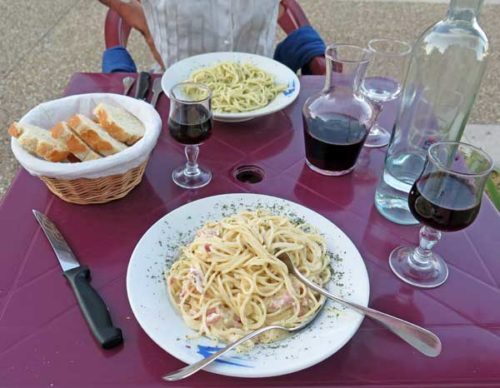
Our main courses were pure comfort food – big bowls of pasta with wine and bread. Keith had carbonara sauce and I had pesto.
On our way back to the tent we checked the opening times of the bar (6:30 am) and the boulangerie (7 am), as we had no intention of setting off along the canal in the morning without a proper breakfast.
Previous day: Mehun-sur-Yèvre to Bourges

